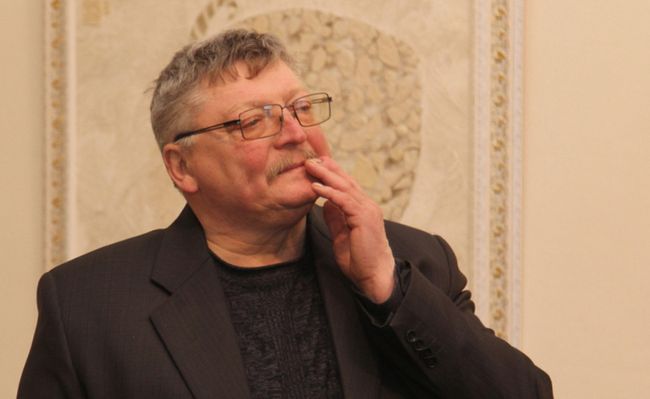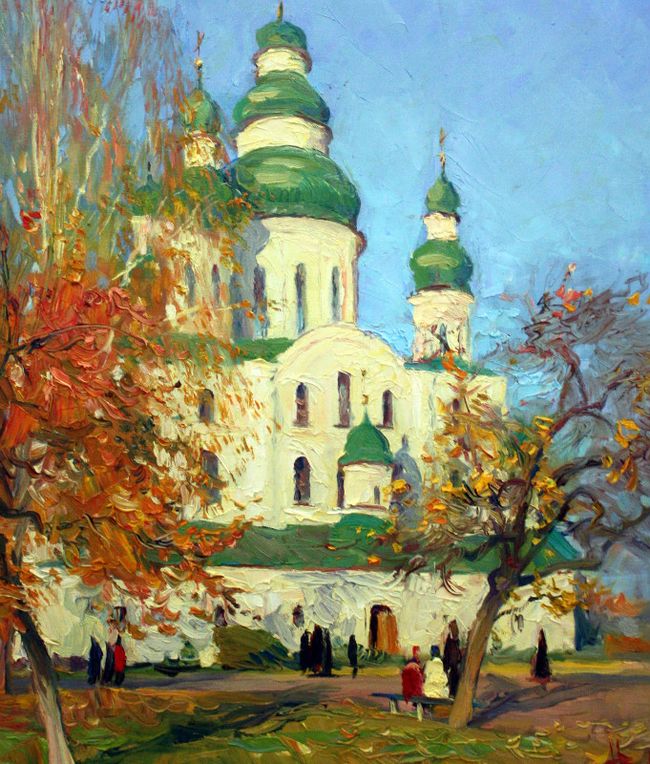Aesthetics of the “enchanted Desna”
On the embodied ideas of Borys Diedov, founder of Plast-Art Museum in Chernihiv
Every great river begins with little streams. The Museum of Contemporary Art “Plast-Art” (Chernihiv) began as a small art studio of Borys Diedov – man of enormous enthusiasm, love of art, and most importantly, the people. Only caring people can do things that are needed for the country and the city. Borys comes from this strain of heroes, whose efforts built temples, academies, gymnasiums, museums. Consistently, step by step Diedov came to realization of his life’s dream – the creation of a modern museum. And today Chernihiv greets leading worldwide and Ukrainian artists within the walls of this museum. And in this regard, the museum and its founder have contributed much to the enlightenment.
For those who would like to serve the culture and art of Ukraine, the example of Borys Diedov’s breakthrough will be interesting and instructive. He was born (on February 21, 1975) and grew up in the picturesque Novhorod-Siverskyi near Chernihiv. His path to higher education was not an easy one: menial work in farming and construction, military service and operations in the Chornobyl zone. But the young man was drawing everywhere. So when he entered the Interior Design and Equipment Department at Kharkiv Art and Industry Institute, he was noticed by a distinguished artist-professor Borys Kosariev. At the times of the avant-garde (the 1920s), he was creating the “Windows of ROST” along with Vladimir Mayakovsky – he made satirical posters. Diedov warmly remembers all his teachers and fellow classmates. As a student he started to have this dream of creating a powerful art center in Chernihiv region.
The dream of a museum began to grow in the early 1990s, when most of the artists had found themselves out of work and any prospects. At that time, in 1994 Diedov established a private ceramic studio that turned a profit and fed the family.
A small studio at the workshop that exhibited artworks by Chernihiv-based artists became the place and the prototype of the future museum. The quality of exhibitions was noted by the leading critics of Ukraine. Happy was the cooperation between Plast-Art (gallery, and later, museum) and Professor Volodymyr Lychkovakh. His analytical exploration provided the gallery with the necessary depth of understanding of contemporary artistic process. And so, art critic Dmytro Korsun wrote on the culture-studies role of Plast-Art: “For the past many years there has been the Museum of Contemporary Art ‘Plast-Art’ in the ancient city of Chernihiv. Displays that are hosted within the walls of the museum, a longtime ago have become important events in social and cultural life of the city. Interestingly, it exhibits the works of not only Chernihiv-based artists with significant creative potential, but also of such from all over Ukraine. Modern art has found permanent residence in the halls of the museum, indicating that the creative search of Ukraine’s artists is unstoppable and spiritual strength of the Museum’s founder is infallible.”
The director and the Museum’s small staff constantly engage in public work for the city of Chernihiv: ceramic murals, stained glass windows, and restoration work in churches. In the 1990s Diedov cooperated with Oleh Vasiuta, who then was the head of the Regional Department for Culture. Together they implemented a series of art projects for the city. They also started cooperation with Poland and Belarus. The Plast-Art Gallery has become a place to be visited by foreign diplomats and cultural figures. In 1995, the Chernihiv gallery joined in Kyiv to the foundation (by the initiative of B. Khamatov) of the Art Galleries Association of Ukraine. It was an innovative movement. Chernihiv began to take part in all art fairs and festivals (Ukrainian House. Kyiv, the 1990s-2000s).

THE PECULIAR FEATURE OF THE CHERNIHIV SCHOOL: UNITY OF NATURAL AND BUILT ENVIRONMENT, ROOTED IN THE DEEP LAYER OF ANCIENT CHERNIHIV’S TRADITIONS (PICTURED: ONE OF 32 WORKS DISPLAYED AT THE “CREATIVE YOUTH OF POLISSIA” EXHIBITION, HOSTED BY THE PLAST-ART MUSEUM)
Diedov’s Plast-Art Gallery and later NGO “Contemporary Art Museum” have launched large-scale exhibition activities. One can be delighted seeing the potential of the museum increase year after year, as well as the kaleidoscope of lively young artists that have just come into art and the powerful, honored artists of contemporary art exist in one space together. It is very important that the museum publishes the catalog of these museum collections each year, as these exhibitions are to some extent a documentary snapshot of what is happening in the visual arts in Chernihiv, and in Ukraine as a whole.
Borys Diedov recalls a somewhat paradoxical episode from 1997. Former dissident Mykhailo Shemiakin came to Kyiv from the US. Diedov invited this star of modernism to exhibit in Chernihiv. As he saw a skeptical smile for a response, Diedov played it cool and continued: “I have a small gallery on Lenin Street in Chernihiv.” Shemiakin laughed and said: “Shemiakin on Lenin Street? A paradox! It’s great.” And the exhibition was held with tremendous success.
In January 2001, the spacious rooms of an old building in the citadel have finally opened as the Museum of Contemporary Art “Plast-Art.” The dream of Borys Diedov came true. But he had not shirked the responsibility of a builder, and even paid at his own expense for revival of the abandoned space. And to this day, Diedov is no stranger to charity. Together with the Rozum Fund and the Panteleimon Kulish Fund, Diedov and Lychkovakh have founded a periodical Dyvosvit. Diedov engages in decorating the facades and interiors of schools. In cooperation with the Order of St. Michael of Chernihiv, the museum and the city government installed a monument to St. Prince Michael and Boyar Theodore, who died for their people. Borys Diedov drafted and participated in the reconstruction of Panteleimon Kulish’s estate.
The Plast-Art Museum also cooperates with Den newspaper. In June 2004, the halls of the Museum have for the first time hosted the photo exhibition “Den-2003,” and since then the newspaper has become a welcome guest in Chernihiv.
For many years the townspeople have acquainted with music festivals and artistic innovations at the Plast-Art Museum. The leading actors are happy to perform here, and here is the place for large-scale cultural festivals of the city.
For several years the museum has implemented the exhibition project “Territory of the Soul.” The display features artists who brought sacred values to the art, who lead a dialog with history, natural environment, traditions of national and worldwide art, as well as with the humanistic component of modern culture. The exhibition “New Names” at the museum supports creative young people of Chernihiv, Kyiv, Lviv. The entire artistic palette of modern Ukraine, from realism to post-post-modernism enjoys the exhibition opportunity at the Chernihiv Museum of Modern Art. Plast-Art reflects the modern artistic process and enriches primarily the artistic life of Chernihiv. However, the contemporary art festival “Territory of the Soul,” which was founded by the museum, has become an important factor in the development and establishment of artistic, historical, and cultural processes of the renewed Ukraine. The variety of socially significant projects and innovative plans of the museum of modern art shows the everyday work of a humble ascetic, the industrious Borys Diedov. He and people like him are “the salt of the earth” and Ukraine’s biggest achievement.
Newspaper output №:
№12, (2017)Section
Culture





